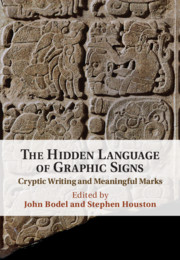Book contents
- The Hidden Language of Graphic Signs
- The Hidden Language of Graphic Signs
- Copyright page
- Contents
- Contributors
- Abbreviations
- Introduction
- Part I Hidden Writing
- One Buried and Camouflaged Writing in Early China
- Two Dazzled and Absorbed
- Three Impossible Unities
- Four Inscribe and De-scribe/Cipher and De-cipher
- Five Script, Pseudoscript, and Pseudo-pseudoscript in the Work of Filippo Lippi
- Six Numerals as Letters
- Part II Legible Signs
- References
- Index
Two - Dazzled and Absorbed
Delayed Reading in Altered Egyptian Hieroglyphic Writing
from Part I - Hidden Writing
Published online by Cambridge University Press: 23 August 2021
- The Hidden Language of Graphic Signs
- The Hidden Language of Graphic Signs
- Copyright page
- Contents
- Contributors
- Abbreviations
- Introduction
- Part I Hidden Writing
- One Buried and Camouflaged Writing in Early China
- Two Dazzled and Absorbed
- Three Impossible Unities
- Four Inscribe and De-scribe/Cipher and De-cipher
- Five Script, Pseudoscript, and Pseudo-pseudoscript in the Work of Filippo Lippi
- Six Numerals as Letters
- Part II Legible Signs
- References
- Index
Summary
This chapter examines writings from Bronze Age China that might at first glance seem to be hidden, asking about their audience and the intentions behind them. It begins at the late second millennium Anyang site with a pit deposit of inscribed oracle bones in the royal precinct. Arguing that the pit was part of a representation of sacrifice, it suggests that the buried writing was offered to the royal ancestors in thanks for their replies to the divination questions. Next it looks at inscriptions on bronze ritual vessels. These originated in the late second millennium as display texts addressed to deceased ancestors but early in the first millennium came to be consciously written for the living as well. A third case is stone tablets inscribed with covenant texts and buried in sacrificial pits at the fifth-century BCE Houma site. Here it seems that rulers seeking to enforce loyalty not only called the spirits to witness but also kept duplicate copies of the covenants as witnesses that could be called in evidence. The chapter concludes with some camouflaged writings from the latter part of the first millennium. These were designed to entertain highly literate readers by provoking mental gymnastics.
Keywords
- Type
- Chapter
- Information
- The Hidden Language of Graphic SignsCryptic Writing and Meaningful Marks, pp. 41 - 53Publisher: Cambridge University PressPrint publication year: 2021

